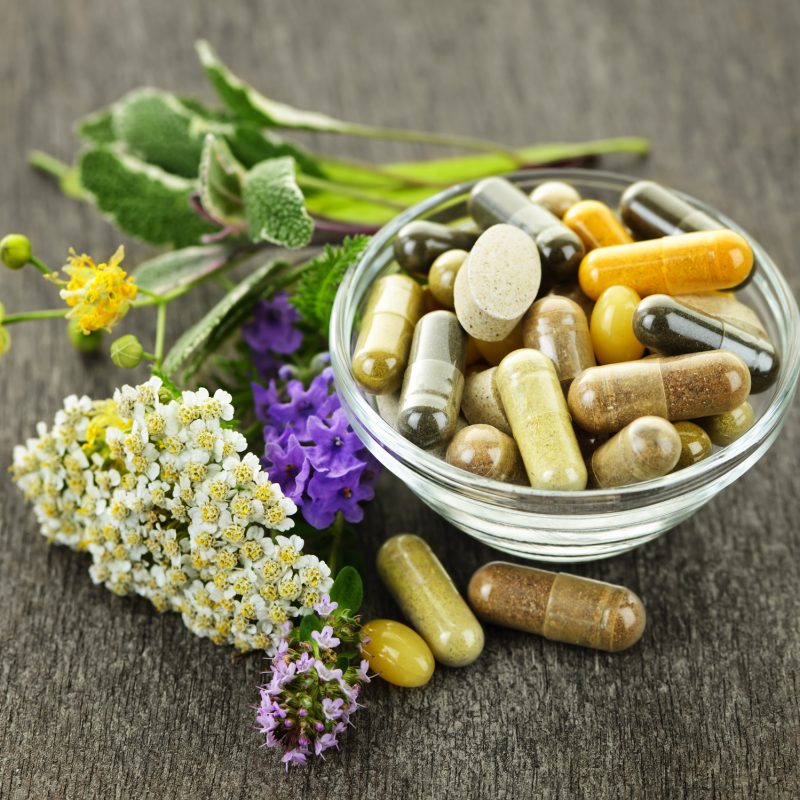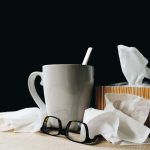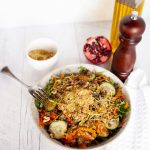
Plants have long demonstrated their ability to provide a plethora of essential metabolites, such as carbohydrates, nucleic acids and lipids, as well as many secondary metabolites such as alkaloids, terpenoids, and phenols. These substances claim to confer a variety of biological qualities, including — but certainly not limited to — anti-inflammatory, hepatoprotective, anti-microbial, antiviral, antibacterial and vasodilatory effects.A large percentage of Americans show an avid interest in such herbal supplements. In this article we offer a thorough discussion into the etiology of herbal adaptogens, their many uses, and the truth about their overall efficacy.
Plants versus Pharmaceuticals
The manufacture of herbal supplements begins with the leaves, roots, seeds, bark, fruit, stems, or flowers of various plants known to possess medical characteristics or offer medicinal benefits. Currently not regulated/recognized as pharmaceuticals by the FDA, they need not go through the same rigorous testing to which the government makes prescription medicines undergo prior to securing a place on the market. Rather, the FDA categorizes and regulates these preparations as “dietary supplements” under the Dietary Supplement Health and Education Act (DSHEA) of 1994.
Why Choose Alternative Medicine?
The growing interest in what we refer to today as alternative medicine, which encompasses regular use of herbal drugs, often baffles both public health professionals and cultural historians alike. Several factors no doubt influenced this shift.
The astronomical rise in health care costs continues to incite a great deal of dissatisfaction with regard to traditional medicine, at least in the U.S. In addition, we continue to witness a growing awareness of serious side effects associated with synthetic medications. Disillusioned with science-forward health care failing to cure so many serious illnesses, coupled with a cultural emphasis on natural wellness, only serves to further steer public interest toward the use of herbal alternatives. After all, the Internet makes it easy enough for curious individuals to do their own research on herbal adaptogens and arrive at their own conclusions.
Adaptogens Clarified
The strict qualifications required to classify a substance as an adaptogen include the following:
- A nontoxic substance that produces only minor alterations in overall physiological functioning
- A generic substance that promotes resistance to various physical, chemical, and biological stressors
- In addition to these aforementioned pathogenic alterations, an adaptogen may confer a normalizing effect
The top 7 adaptogens commonly used worldwide have undergone intensive research. We list them here; however, the context of this article remains limited to discussion of only a select few.
- Turmeric
- Ashwagandha
- Ginseng
- Cordyceps
- Holy Basil
- Rhodiola Roseas
- Schisandra
Global Interest
Herbal therapeutic use exists even outside the United States. Europeans spend three times as much on herbal drugs as individuals in this country. In Germany alone, 66% of the population embrace herbal drugs; furthermore, herbal medicines comprise 30% of all drugs sold in German pharmacies, no doubt because German physicians routinely prescribe these medicines. Unlike in our country, the German equivalent of our FDA includes these adaptogens in their rigorous evaluation/regulations processes, thereby instilling a much greater level of confidence in consumers. Worldwide, more than 80% of the population welcomes and trusts the use of herbal and folk remedies, particularly in Third World countries with scant access to modern healthcare and pharmaceuticals.
Composition Complexities
Manufacturers of herbal medicines often find it challenging to quantify/standardize exactly how much of any active ingredient a particular product actually contains. One manufacturing company may pulverize a plant or herb for use in a capsule form, whereas another lab may favor the use of the plant/herbal extract. Consumer Reports magazine delved into the herbal adaptogen industry, discovering the potency of products utilizing the identical plant species could vary as much as 10,000 -fold. In addition, herbal products do not always contain the plant they claim; seasonal unavailability of certain herbs and plant varieties lead some labs to use lesser-known, cheaper sources that “supposedly” yield similar results.
Manner of Consumption Can Vary Greatly
Proponents of natural plant-based treatments have found a multitude of ways in which to use these preparations, depending in large part on manufacturing and/or the condition one hopes to treat.
- decoction ~ tea made from boiling the bark, roots, or other woody parts of the plant in water.
- infusion~ tea made by pouring hot water over the dried leaves, flowers, or fruit of the plant and allowing it to steep. Typical infusions call for boiling water; however, some infusions do use cold water.
- tincture~ extract of the plant made by soaking herbs in glycerin, alcohol, or vinegar for several weeks. The resulting liquid, strained from the plant, works well therapeutically by adding it to hot water and/or other beverages. Some individuals take tinctures directly by the spoonful.
- liniment~ extract of an herb added to either alcohol or vinegar and then applied topically.
- poultice~ soft, moist mass of crushed plant material wrapped in a finely woven cloth, used topically as a medicinal salve for skin disorders.
Plant-Based Supplements for Exercise Enhancement
The fitness world witnessed a skyrocketing level of herbal supplement usage over the past ten years. Athletes and non-athletes alike reach for herbal medicines to enhance various aspects of their lives. In 2021, the value attributed to the worldwide herbal medicine market ran close to $151.91 billion. Statisticians foresee the market developing at a compounded annual growth rate of 11.6% between the years 2022 and 2029, rising from $165.66 billion to $347.50 billion.
Athletes use herbal adaptogens to offset many impairments/conditions which directly relate to the body’s stress levels and commensurate management. These supplements likewise claim to enhance focus, boost endurance during moments of peak fatigue, improve physical strength/stamina, enhance energy levels, restore stress-affected cognitive function and maintain appropriate levels of cortisol.
In an effort to gain a more competitive edge, athletes have found significant success with herbal medicine in terms of reducing performance-related anxiety prior to events. This practice goes back close to 2,000 years, when the herbal remedy Bai Shao demonstrated the ability to improve physical strength. Athletes typically turn to sports-enhancing herbal supplements during activities like rowing, walking, running, cycling, and mountaineering. We also see strength-focused athletes using such products during serious bouts of bodybuilding, wrestling and competitive weightlifting.
Herbal medicine and sports enjoy a somewhat symbiotic relationship; competitive sports events have fostered the growth of herbal medicine, and expanded access to pharmaceutical treatments for illnesses linked to injuries. We often find athletics aligning with Traditional Chinese Medicine (TCM); the increasing intensity of athletic competition seems to have influenced an uptick in TCM’s development; concurrently, experts find that TCM methodologies benefit greatly from advancements in sports-related pharmacological treatments.
Pros and Cons of Popular Herbal Remedies
As mentioned above, the remainder of this article will contain a closer look at several of the most widely-used herbal supplements.
- Ashwagandha
Derived from dehydrated stems and roots of the Solanaceae plant, this herb grows in Pakistan, Africa, India, and the Mediterranean. Studies undertaken to ascertain the effect of Ashwagandha on the aerobic capacity of elite Indian cyclists revealed that 0.5 g aqueous extract of the roots of Ashwagandha taken twice daily over the course of 8 weeks improved VO2max, or maximum oxygen consumption, which in turn increases athletes’ endurance capacity.
Similarly, another research study looked at potential advantages of the consumption of ashwagandha root extract on strength and muscular development in young, healthy males engaged in resistance training. When compared to the control group who received a placebo, these subjects showed marked improvements in muscular strength (as demonstrated with a bench press) as well as increased hypertrophy in both the biceps and pectoral muscles.
- Rhodiola Roseas
This plant, often taken as a means of increasing physical endurance, grows in the coastal regions of North America as well as in the crevices of mountain rocks found in the Arctic regions of Europe and Asia. In a controlled study lasting 28 days, 14 male athletes supplemented regularly with Rhodiola Roseas, which scientists believe might reduce both lactate levels and parameters of skeletal muscle damage following intense physical exertion, while also improving the body’s consumption of fatty acids. The tandem occurrence of these results confirmed the hypothesis that Rhodiola Rosea may increase an athlete’s adaptability to physical activity.
- Cordyceps
Cordyceps sinensis, one of 350+ species belonging to the Fungi genus, ranks highly in terms of pharmaceutical bioactivity, and boasts a long history as a therapeutic herbal adaptogen. The scientific community first took notice of this herb when, in 1993, Chinese athletes who had supplemented with Cordyceps sinensis shattered world records in track and field. However, the international athletics community now views these records with considerable suspicion, due to a letter published 20 years later by 10 Chinese track & field athletes admitting to doping during the time frame in question.
These facts notwithstanding, research scientists did study the effects on 30 marathon runners of a daily dosage of 2 grams of Cordyceps sinensis over the course of 12 weeks. According to the study, such supplementation improved aerobic performance/endurance capacity. However, the general fitness community will await other studies in order to confirm this effect, striving for a larger number of both active and sedentary volunteer subjects.
- Turmeric
Scientists at the Universitat Oberta de Catalunya have found that turmeric and its primary related product curcumin, may reduce muscle damage and inflammation in the musculoskeletal system following vigorous physical exercise. “Both pre- and post-exercise curcumin consumption are associated with better outcomes in terms of muscle recovery, reduced pain and improved antioxidant capacity”, said Daniel Vasile Popescu-Radu, a pharmacist, nutritionist and doctoral student with a passion for how food affects physical exercise/sports.
According to the researchers, the possible benefits of turmeric/curcumin include mitigating local and systemic muscle inflammation as well as oxidative damage resulting from exercise-induced free-radical production. This, in turn, alters the athlete’s perception of pain as well as the ROM associated with the muscle group(s) utilized during eccentric exercise, which seems to incite the most muscle damage. “Moderate curcumin intake within the established post-exercise dosage range helps improve and speed up muscle recovery,” said Popescu-Radu, who further explained that “an expert can adjust the dosage and timing of intake to optimize its benefits.”
The Potential Health Risks Associated with Herbal Treatments
We must not assume that, simply because herbs reflect nature and confer positive benefits to the body, they must not have a dangerous downside. As mentioned earlier, the US Food and Drug Administration (FDA) does not closely regulate herbal supplements for purity/potency prior to marketing. As such, medical professionals — particularly in hospitals and emergency rooms — have a growing concern for health risks associated with herbal adaptogen overuse, due to mislabeled/potentially toxic ingredients, contaminants, and dangerous interactions when taken in tandem with prescription medications. The consequences of consuming “too much of a good thing” include allergic reactions, damage to one’s DNA, carcinogenicity, organ damage and even fatalities.
Physicians often tend to shy away from recommending herbal supplementation due to a lack of knowledge and/or interest. Therefore, the onus of responsibility falls upon the consumer. High-risk populations, such as those in both the pediatric and geriatric age demographic, pregnant/lactating mothers, and individuals with compromised immune systems might choose to delve more deeply into traditional herbal medicine prior to setting out upon this path.
Final Thoughts on the Herbal Controversy
Opponents of herbal drugs point to the lack of conclusive evidence proving the efficacy of such supplements. Individuals in this camp, concerned about the lack of standards that have led to toxic and/or fatal side effects as well as adverse reactions, continue to advocate for more FDA involvement. Proponents of these supplements argue that herbal remedies, used safely and effectively for eons, have stood the test of time. In addition, they cite the growing number of scientific studies which indicate that some herbal medicines live up to their health claims. The need for additional research/testing seems important to both sides, especially in determining which herbs, if any, may bring about the aforementioned deleterious effects experienced by certain individuals.
References:
https://www.encyclopedia.com/science/applied-and-social-sciences-magazines/herbal-drugs
https://www.researchandmarkets.com/reports/5649101/adaptogens-market-forecasts-from-2025-to-2030
https://www.openmedicinalchemistryjournal.com/VOLUME/18/ELOCATOR/e18741045309981/FULLTEXT/
https://pubmed.ncbi.nlm.nih.gov/20308973/
https://www.sciencedirect.com/science/article/abs/pii/S2210803322000392?via%3Dihub






